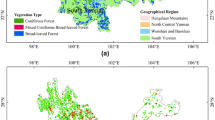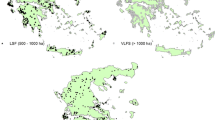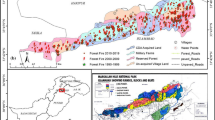Abstract
The aim of this study was to improve our understanding of factors that affect the spatial distribution of wildfire occurrences at the regional scale. We employed the random forest, boosted regression tree, and genetic algorithm rule-set production models to assess the spatial interplay between fire events and climate, topography, and anthropogenic factors in order to characterize wildfire occurrence in the Zagros eco-region of western Iran. We constructed a geospatial database using the historical fires from the period 2007–2020 and topography, climate, and human related factors. The results demonstrated that human activities (i.e., land use and distance from the settlements and roads) contributed 45% to the probability model of wildfire occurrence in the study region. The models ranked the climate factors (rainfall, temperature, and wind effect) as the second most influential drivers of fire occurrences, whereas topographic features (slope, elevation, and aspect) did not significantly influence fire probability in the landscape. Overall model performance was assessed with the area under the receiver operating characteristic (AUROC) method that showed the superior performance of the RF model in the training phase (AUROC = 0.92) and in its ability to predict upcoming fires (AUROC = 0.90). The insights obtained from this research can bring into focus both the locations and the types of suppression policies that are required to alleviate the effects of the upcoming wildfires in the early twenty-first century.







Similar content being viewed by others
References
Adab H, Kanniah KD, Solaimani K (2013) Modeling forest fire risk in the northeast of Iran using remote sensing and GIS techniques. Nat Hazards 65:1723–1743
Adab H, Atabati A, Oliveira S, Gheshlagh AM (2018) Assessing fire hazard potential and its main drivers in Mazandaran province, Iran: a data-driven approach. Environ Monit Assess 190:670
Breiman L (2001) Random forests. Mach Learn 45:5–32
Carmo M, Moreira F, Casimiro P, Vaz P (2011) Land use and topography influences on wildfire occurrence in northern Portugal. Landsc Urban Plan 100:169–176
Chen X, Quan Q, Zhang K, Wei J (2021) Spatiotemporal characteristics and attribution of dry/wet conditions in the Weihe River Basin within a typical monsoon transition zone of East Asia over the recent 547 years. Environ Model Softw 143:105116
Chen Z, Liu Z, Yin L, Zheng W (2022) Statistical analysis of regional air temperature characteristics before and after dam construction. Urban Clim 41:101085
Chuvieco E et al (2010) Development of a framework for fire risk assessment using remote sensing and geographic information system technologies. Ecol Model 221:46–58
Collins KM, Price OF, Penman TD (2015) Spatial patterns of wildfire ignitions in south-eastern Australia. Int J Wildland Fire 24:1098–1108
Darabi H et al (2019) Urban flood risk mapping using the GARP and QUEST models: a comparative study of machine learning techniques. J Hydrol 569:142–154
Dennison PE, Brewer SC, Arnold JD, Moritz MA (2014) Large wildfire trends in the western United States, 1984–2011. Geophys Res Lett 41:2928–2933
Elia M, D’Este M, Ascoli D, Giannico V, Spano G, Ganga A, Colangelo G, Lafortezza R, Sanesi G (2020) Estimating the probability of wildfire occurrence in Mediterranean landscapes using artificial neural networks. Environ Impact Assess Rev 85:106474
Feria A, Peterson T (2002) Prediction of bird community composition based on point-occurrence data and inferential algorithms: a valuable tool in biodiversity assessments. Divers Distrib 8:49–56
Flannigan MD, Krawchuk MA, de Groot WJ, Wotton BM, Gowman LM (2009) Implications of changing climate for global wildland fire. Int J Wildland Fire 18:483–507
Ghorbanzadeh O et al (2019) Spatial prediction of wildfire susceptibility using field survey GPS data and machine learning approaches. Fire 2(3):43
Giglio L, Descloitres J, Justice CO, Kaufman YJ (2003) An enhanced contextual fire detection algorithm for MODIS. Remote Sens Environ 87:273–282
Gillett N, Weaver A, Zwiers F, Flannigan M (2004) Detecting the effect of climate change on Canadian forest fires. Geophys Res Lett 31:18
Goleiji E, Hosseini SM, Khorasani N, Monavari SM (2017) Forest fire risk assessment-an integrated approach based on multicriteria evaluation. Environ Monit Assess 189:612
Gralewicz NJ, Nelson TA, Wulder MA (2012) Factors influencing national scale wildfire susceptibility in Canada. For Ecol Manag 265:20–29
Hong H, Jaafari A, Zenner EK (2019) Predicting spatial patterns of wildfire susceptibility in the Huichang County, China: an integrated model to analysis of landscape indicators. Ecol Ind 101:878–891
Hyde K, Dickinson MB, Bohrer G, Calkin D, Evers L, Gilbertson-Day J, Nicolet T, Ryan K, Tague C (2013) Research and development supporting risk-based wildfire effects prediction for fuels and fire management: status and needs. Int J Wildland Fire 22(1):37–50
Jaafari A, Pourghasemi HR (2019) Factors influencing regional-scale wildfire probability in Iran: an application of random forest and support vector machine. In: Pourghasemi HR, Gokceoglu C (eds) Spatial modeling in GIS and R for earth and environmental sciences. Elsevier, pp 607–619
Jaafari A, Gholami DM, Zenner EK (2017) A Bayesian modeling of wildfire probability in the Zagros Mountains. Iran Ecol Inform 39:32–44
Jaafari A, Zenner EK, Pham BT (2018) Wildfire spatial pattern analysis in the Zagros Mountains, Iran: a comparative study of decision tree based classifiers. Ecol Inform 43:200–211
Jaafari A, Mafi-Gholami D, Pham BT, Tien Bui D (2019a) Wildfire probability mapping: bivariate vs. multivariate statistics. Remote Sens 11:618
Jaafari A, Razavi Termeh SV, Bui DT (2019b) Genetic and firefly metaheuristic algorithms for an optimized neuro-fuzzy prediction modeling of wildfire probability. J Environ Manag 243:358–369
Lan Z, Zhao Y, Zhang J, Jiao R, Khan MN, Sial TA, Si B (2021) Long-term vegetation restoration increases deep soil carbon storage in the Northern Loess Plateau. Sci Rep 11(1):1–11
Li J, Zhao Y, Zhang A, Song B, Hill RL (2021) Effect of grazing exclusion on nitrous oxide emissions during freeze–thaw cycles in a typical steppe of Inner Mongolia. Agric Ecosyst Environ 307:107217
Ließ M, Glaser B, Huwe B (2012) Uncertainty in the spatial prediction of soil texture: comparison of regression tree and Random Forest models. Geoderma 170:70–79
Liu Y, Zhang K, Li Z, Liu Z, Wang J, Huang P (2020) A hybrid runoff generation modelling framework based on spatial combination of three runoff generation schemes for semi-humid and semi-arid watersheds. J Hydrol 590:125440
Liu B, Spiekermann R, Zhao C, Püttmann W, Sun Y, Jasper A, Uhl D (2022) Evidence for the repeated occurrence of wildfires in an upper Pliocene lignite deposit from Yunnan, SW China. Int J Coal Geol 250:103924
Naderpour M, Rizeei HM, Ramezani F (2021) Forest fire risk prediction: a spatial deep neural network-based framework. Remote Sens 13(13):2513
Oliveira S, Oehler F, San-Miguel-Ayanz J, Camia A, Pereira JM (2012) Modeling spatial patterns of fire occurrence in Mediterranean Europe using Multiple Regression and Random Forest. For Ecol Manag 275:117–129
Pausas JG, Keeley JE (2009) A burning story: the role of fire in the history of life. Bioscience 59:593–601
Pourtaghi ZS, Pourghasemi HR, Aretano R, Semeraro T (2016) Investigation of general indicators influencing on forest fire and its susceptibility modeling using different data mining techniques. Ecol Ind 64:72–84
Quan Q, Liang W, Yan D, Lei J (2022) Influences of joint action of natural and social factors on atmospheric process of hydrological cycle in Inner Mongolia. China Urban Clim 41:101043
Rahmati O, Golkarian A, Biggs T, Keesstra S, Mohammadi F, Daliakopoulos IN (2019) Land subsidence hazard modeling: machine learning to identify predictors and the role of human activities. J Environ Manag 236:466–480
Rasooli SB, Rashidi S, Shabanian N (2021) Fire sensitivity of broadleaf tree species in plantations of Kurdistan, Iran. J for Res 32(3):1167–1176
Ridgeway G (2007) Generalized boosted models: a guide to the gbm package. Update 1(1):1–15
Rodrigues M, Jiménez-Ruano A, Peña-Angulo D, de la Riva J (2018) A comprehensive spatial-temporal analysis of driving factors of human-caused wildfires in Spain using geographically weighted logistic regression. J Environ Manag 225:177–192
Sari F (2021) Forest fire susceptibility mapping via multi-criteria decision analysis techniques for Mugla, Turkey: a comparative analysis of VIKOR and TOPSIS. For Ecol Manag 480:118644
Satir O, Berberoglu S, Donmez C (2016) Mapping regional forest fire probability using artificial neural network model in a Mediterranean forest ecosystem. Geomat Nat Haz Risk 7:1645–1658
Shabani S, Jaafari A, Bettinger P (2021) Spatial modeling of forest stand susceptibility to logging operations. Environ Impact Assess Rev 89:106601
Spano G, Elia M, Cappelluti O, Colangelo G, Giannico V, D’Este M, Lafortezza R, Sanesi G (2021) Is experience the best teacher? Knowledge, perceptions, and awareness of wildfire risk. Int J Environ Res Public Health 18(16):8385
Stocks BJ et al (1998) Climate change and forest fire potential in Russian and Canadian boreal forests. Clim Change 38:1–13
Stockwell D (1999) The GARP modelling system: problems and solutions to automated spatial prediction. Int J Geogr Inf Sci 13:143–158
Swain DL (2021) A shorter, sharper rainy season amplifies California wildfire risk. Geophys Res Lett 48(5):e2021GL092843
Syphard AD et al (2008) Predicting spatial patterns of fire on a southern California landscape. Int J Wildland Fire 17:602–613
Tavakkoli Piralilou S, Einali G, Ghorbanzadeh O, Nachappa TG, Gholamnia K, Blaschke T, Ghamisi P (2022) A Google Earth Engine approach for wildfire susceptibility prediction fusion with remote sensing data of different spatial resolutions. Remote Sens 14(3):672
Valdez MC, Chang KT, Chen CF, Chiang SH, Santos JL (2017) Modelling the spatial variability of wildfire susceptibility in Honduras using remote sensing and geographical information systems. Geomat Nat Haz Risk 8(2):876–892
Viedma O, Urbieta I, Moreno J (2018) Wildfires and the role of their drivers are changing over time in a large rural area of west-central Spain. Sci Rep 8:17797
Vilar L, Woolford DG, Martell DL, Martín MP (2010) A model for predicting human-caused wildfire occurrence in the region of Madrid, Spain. Int J Wildland Fire 19:325–337
Wu Z, He HS, Yang J, Liu Z, Liang Y (2014) Relative effects of climatic and local factors on fire occurrence in boreal forest landscapes of northeastern China. Sci Total Environ 493:472–480
Wu Z, He HS, Yang J, Liang Y (2015) Defining fire environment zones in the boreal forests of northeastern China. Sci Total Environ 518:106–116
Xie W, Li X, Jian W, Yang Y, Liu H, Robledo LF, Nie W (2021a) A novel hybrid method for landslide susceptibility mapping-based geodetector and machine learning cluster: a case of Xiaojin county, China. ISPRS Int J Geo-Inf 10(2):93
Xie W, Nie W, Saffari P, Robledo LF, Descote PY, Jian W (2021b) Landslide hazard assessment based on Bayesian optimization–support vector machine in Nanping City, China. Nat Hazards 109(1):931–948
Yin L, Wang L, Zheng W, Ge L, Tian J, Liu Y, Yang B, Liu S (2022) Evaluation of empirical atmospheric models using Swarm-C satellite data. Atmosphere 13(2):294
Zhang G, Wang M, Liu K (2019a) Forest Fire susceptibility modeling using a convolutional neural network for Yunnan Province of China. Int J Disaster Risk Sci 10(3):386–403
Zhang K, Ali A, Antonarakis A, Moghaddam M, Saatchi S, Tabatabaeenejad A, Chen R, Jaruwatanadilok S, Cuenca R, Crow WT, Moorcroft P (2019b) The sensitivity of North American terrestrial carbon fluxes to spatial and temporal variation in soil moisture: an analysis using radar-derived estimates of root-zone soil moisture. J Geophys Res Biogeosci 124(11):3208–3231
Zhang K, Wang S, Bao H, Zhao X (2019c) Characteristics and influencing factors of rainfall-induced landslide and debris flow hazards in Shaanxi Province, China. Nat Hazard 19(1):93–105
Zhao X, Xia H, Pan L, Song H, Niu W, Wang R, Li R, Bian X, Guo Y, Qin Y (2021) Drought monitoring over Yellow River basin from 2003–2019 using reconstructed MODIS land surface temperature in Google Earth Engine. Remote Sens 13(18):3748
Funding
This study was funded by Research Institute of Forests and Rangelands (RIFR) as part of the National Research Project No. 0-09-09-002-000095.
Author information
Authors and Affiliations
Corresponding author
Ethics declarations
Conflict of interest
The authors declared that they have no conflict of interest.
Additional information
Publisher's Note
Springer Nature remains neutral with regard to jurisdictional claims in published maps and institutional affiliations.
Rights and permissions
About this article
Cite this article
Jaafari, A., Rahmati, O., Zenner, E.K. et al. Anthropogenic activities amplify wildfire occurrence in the Zagros eco-region of western Iran. Nat Hazards 114, 457–473 (2022). https://doi.org/10.1007/s11069-022-05397-6
Received:
Accepted:
Published:
Issue Date:
DOI: https://doi.org/10.1007/s11069-022-05397-6




